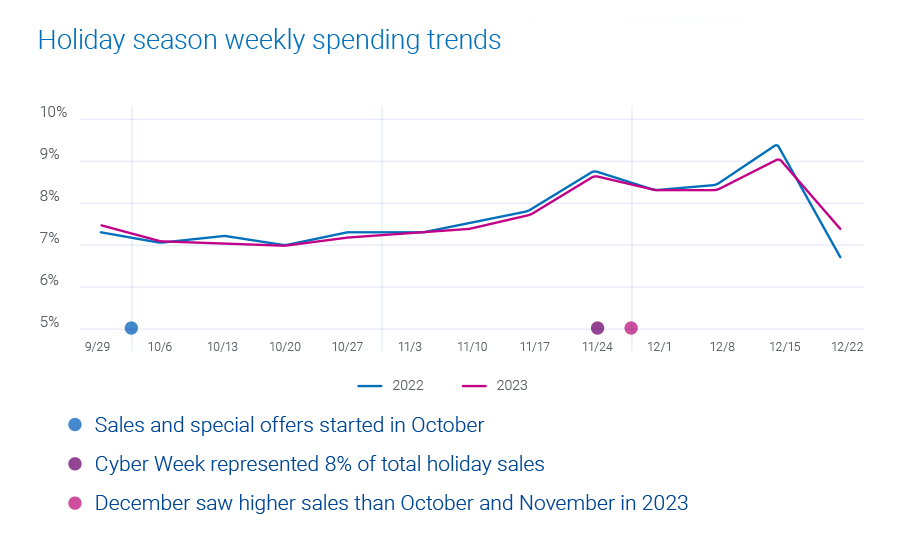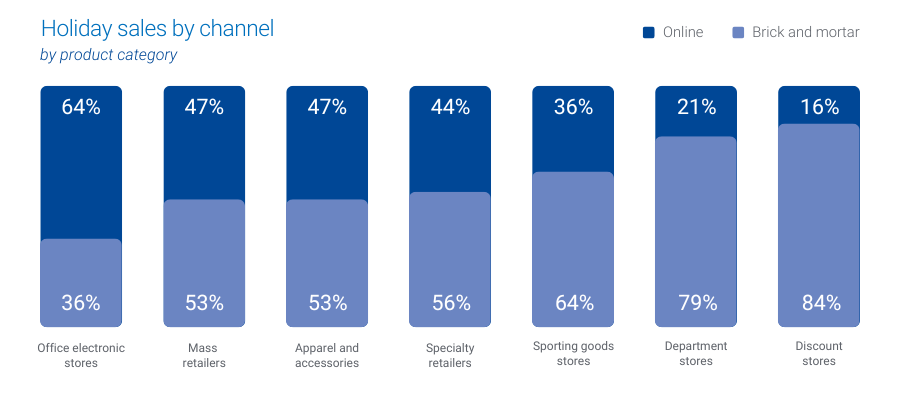
This holiday shopping season, marketers will look to take advantage of the surge in spending across channels like connected TV (CTV), programmatic, and mobile. Despite challenges such as privacy regulations and Google’s new cookie deprecation plan, this moment presents a unique opportunity for marketers to reshape their traditional approaches to consumer engagement and capitalize on these changes.
As we approach the holiday season, understanding how consumers spend, where they shop, and how their shopping habits are changing are key components to consider when crafting your holiday advertising campaigns. Our 2024 Holiday spending trends and insights report utilizes our expertise in data and insights to highlight emerging consumer behaviors and spending patterns. In our report, we share what these trends mean for marketers and how Experian can help, so you can refine your messaging and target the right audience through the best channels.
In this blog post, we cover three insights from our report. Watch our video for a recap below.
1. Consumers are shopping evenly throughout the holiday season
35% of holiday shopping was done in December, peaking at 9% of total holiday sales the week before Christmas. Cyber Week, the five-day period between Thanksgiving and Cyber Monday, and the week before Christmas brought the highest weekly sales for the past two holiday seasons.

What this means for marketers
Prepare for an extended promotional period. Schedule your marketing campaigns and sales initiatives to maximize impact during the extended season, focusing on the peaks of Cyber Week and the week before Christmas.
How Experian can help you target these shoppers
Experian’s data, ranked #1 in accuracy by Truthset, offers advertisers the ability to reach people based on demographic, geographic, and behavioral attributes (e.g. websites visited and purchase history). Our audiences are available on-the-shelf of most major platforms, making it easy for you to activate and target holiday shoppers.
We recently released 19 new holiday-focused audience segments. Here are a few you can activate:
- Black Friday Shoppers
- Cyber Monday Shoppers
- Big Box/Club Store Shoppers
- Luxury Gift Shoppers
- Discount Holiday Shoppers
- Holiday Airline Travel
2. Online shopping is leveling out
Online holiday spending continues to remain around a third of all holiday shopping spending.
We are starting to see online shopping slow and level out – people are going back in-store. The high amount of online shopping we saw during the pandemic is starting to return to pre-pandemic behaviors.

Consumers are spending more in-store at department and discount stores but are shopping online for office/electronics/games, mass retailers, and apparel.

- 84% of holiday shopping was done in-store for discount stores.
- 79% of holiday shopping was done in-store for department stores.
- 64% of holiday shopping was done online for office, electronics, and games stores.
What this means for marketers
Digital and physical experiences work together. Retailers should have a multi-channel plan to reach consumers, tailoring their approach to their target audience and product and creating engaging in-store experiences to drive visitors.
How Experian can help you target and measure across channels
We connect online and offline data to enable precise targeting and measurement of marketing efforts across multiple channels. Read our case study with Cuebiq to learn how they used our Activity Feed solution to deliver in-store lift analyses to their clients.
3. CTV is the top channel to reach consumers
Over two-thirds of the U.S. population now use CTV, and the average time spent among adults is expected to surpass two hours per day in 2024. CTV offers a creative ad experience similar to its linear counterpart but provides more sophisticated targeting and analytics capabilities.
What this means for marketers
As CTV viewing continues to dominate, the importance of cross-device targeting and measurement increases.
How Experian can help you reach shoppers across devices
Later this year, we’ll add support for IPv6 in our Digital Graph as well as phone-based UID2s. This is in addition to our current coverage of IPv4 and email-based UID2s. As a result, all IP signals and UID2s will be resolved back to Experian’s household and individual profiles and their associated devices, which means marketers and platforms can better understand the full customer journey and reach people across their devices.
Download our 2024 Holiday spending trends and insights report
This holiday season is about more than just transactions – it’s about cultivating meaningful connections with your audience. Download our 2024 Holiday spending trends and insights report to access all of our predictions for this year’s holiday season.
When you work with Experian for your holiday shopping campaigns, you’re getting:
- Accurate consumer insights: Better understand your customers’ behavioral and demographic attributes with our #1 ranked data covering the full U.S. population.
- Signal-agnostic identity solutions: Our deep understanding of people in the offline and digital worlds provides you a persistent linkage of personally identifiable information (PII) data and digital IDs, ensuring you accurate cross-device targeting, addressability and measurement.
- Secure connectivity: Bring data and identity to life in a way that meets your needs by securely sharing data between partners, utilizing the integrations we have across the ecosystem, and using our marketing data in flexible ways.
Make the most of this holiday shopping season with Experian. Contact us today to get started.
Latest posts

Tapad's integration with Knorex's XPO™ platform will complement cross-channel optimization capabilities for brands and agencies in the U.S. and APAC markets NEW YORK and SINGAPORE, Dec. 10, 2019 /PRNewswire/ — Tapad, part of Experian and a global leader in digital identity resolution, has partnered with Knorex, a leading provider of digital performance marketing. Knorex's self-service online advertising platform, Knorex XPO™, enables marketers to advertise globally in real-time across different media channels, formats, platforms and devices. Tapad's global, privacy-safe digital cross-device solution, The Tapad Graph, will compliment Knorex XPO™'s own device data set for enhanced marketing capabilities. For Knorex, the integration enables their brand direct and agency customers to gain a more accurate understanding of consumers across devices to reduce campaign inefficiencies and duplication, and to effectively manage frequency capping and attribution. Abhishek Kumar, VP of Engineering at Knorex commented, "Today's digital consumer is raising the bar for marketers. With increasing marketing complexities and consumer device usage, this integration enables marketers to understand the consumer decision journey with heightened ease. Our combined offering will empower agencies in the APAC and US markets, providing an improved marketing solution that will help to streamline their efforts." Abhay Doshi, Head of APAC at Tapad added: "The Tapad Graph, when integrated with the Knorex XPO platform, should not only help U.S. and APAC marketers optimize campaign performance through cross device marketing – but also increase the opportunity for brands to reach out to their target customers within a desired time." To learn more about Tapad and our digital identity resolution capabilities, visit https://www.experian.com/marketing/consumer-sync About TapadTapad, Inc. is a global leader in digital identity resolution. The Tapad Graph and its related solutions provide a transparent, privacy-safe approach connecting brands to consumers through their devices globally. Tapad is recognized across the industry for its product innovation, workplace culture, and talent, and has earned numerous awards including One World Identity's 2019 Top 100 Influencers in Identity Award. Headquartered in New York, Tapad also has offices in Chicago, London, Oslo, Singapore, and Tokyo. About KnorexKnorex provides programmatic advertising products and technologies to advertising buyers worldwide. With its cloud-based online advertising platform, Knorex XPO™ enables ad buyers to self-serve and advertise real-time across the globe regardless of the media channels (social, search, OTT/CTV, video, web/mobile etc.), ad formats (display, native, search, social, video etc) and devices (desktop, laptop, smartphones and tablets) to deliver personalized marketing messages to the target audience in an automated way, powered by machine learning/AI. Underpinned by a multi-layered data-driven approach, XPO simplifies the execution and optimization of marketing campaigns, while delivering measurable and attributable performance. Contact us today!

Tapad, now part of Experian, technology now powers Lifesight's real world intelligence platform with cross-device and reach expansion in the Asia Pacific Region SINGAPORE, Nov. 20, 2019 /PRNewswire/ — Tapad, part of Experian and a global leader in digital identity resolution, today announced a new partnership with Lifesight, a leading provider of real world intelligence for advertisers in the Asia Pacific region (APAC). With the combined offering of The Tapad Graph, Tapad's global, privacy-safe digital cross-device solution, and Lifesight's real world intelligence platform, brands and agencies across APAC can benefit from better consumer targeting, expanded reach for targeted audiences and web-to-mobile footfall attribution. Through this multi-layered offering, Lifesight's brand and agency partners can access an omnichannel view of consumers' paths to purchase, thereby enabling them to increase the reach, measurability and ROI of their advertising campaigns. Rohit Maheswaran, Co-founder of Lifesight commented, "The consumer journey is getting increasingly more complex with ever changing digital and physical world behaviours, making it difficult for marketers to make strategic marketing spend decisions. That's why it's our mission at Lifesight to empower the brands and agencies within the APAC market to achieve better targeting and measurement capabilities, and our partnership with Tapad will help further this cause." Abhay Doshi, Head of APAC at Tapad added, "The Tapad Graph, which enables a unified view of consumers across their multiple digital devices, has a reach of 1 billion devices across the APAC market today. Paired with Lifesight's consumer insights of more than 500 million unique devices, this valuable partnership will offer the market extended consumer reach and prove beneficial to brands and advertisers across APAC who have historically struggled with resolving attribution." To learn more about Tapad and our digital identity resolution capabilities, visit www.experian.com/marketing/consumer-sync About Tapad Tapad, Inc. is a global leader in digital identity resolution. The Tapad Graph, and its related solutions, provide a transparent, privacy-safe approach connecting brands to consumers through their devices globally. Our one-of-a-kind Graph Select offering enables marketers the flexibility and freedom of choice to correlate devices to varied objectives, driving campaign effectiveness and business results. Tapad is recognized across the industry for its product innovation, workplace culture and talent, and has earned numerous awards including One World Identity's 2019 Top 100 Influencers in Identity Award. Headquartered in New York, Tapad also has offices in Chicago, London, Oslo, Singapore and Tokyo. About Lifesight: Lifesight is Asia's leading real world intelligence company that helps marketers understand, target, and measure consumers based on their real world behaviour. Lifesight's robust platform and data solutions power business decisioning, audience activation, footfall measurement, and in-depth location analytics for leading brands and enterprises. The company is headquartered in Singapore with a rapidly expanding footprint in the Asia Pacific region operating in India, Malaysia, Indonesia, UAE, Saudi Arabia, Thailand, Philippines, Vietnam, Japan, Australia and New Zealand. To learn more, visit https://www.lifesight.io/ Contact us today!

The world of healthcare is often left to the doctors, surgeons and scientists. They examine our bodies, organs and genetics, determining if we are healthy and advising accordingly if we are not. This trust is well-warranted, as they spend years studying and practicing to ensure their patients receive the best care possible. However, individual health status is far more complicated than that, and cannot only be restricted to biology and chemistry. There are other factors that impact our well-being that must be accounted for in order to form a comprehensive picture of our necessary healthcare. Social Determinants of Health (or SDOH) are the conditions in which people are born, grow, live, work and age that shape our everyday health. They include socioeconomic factors such as education, neighborhood and housing, employment, social support networks and accessible transportation, among others. While not directly related to our clinical health, they still account for, and influence, many of our health outcomes. Take an elderly man proudly living alone in small town USA. Managing his diabetes is increasingly challenging. He had to give up his car eight months ago, so getting to his regular medical check-ups is a struggle. Without ongoing preventative care and maintenance, this gentleman will end up in the ER with possibly life-threatening conditions. If his physician can detect the change in his access to transportation, they can connect this patient to an eldercare transportation provider, enabling ongoing preventative care and thus avoiding costly emergency visits to the hospital. Access to transportation, healthier food, higher education and even parks can be a lifesaving factor in certain scenarios. This means that healthcare companies cannot rely solely on clinical or claims data if they wish to provide the best and most impactful care planning for their patients. They must take everything into account, from education to lifestyle to neighborhood. By looking at all available data, healthcare providers are able to get a more holistic view of the consumer and drive care plans that deliver better outcomes. Unfortunately, much of this data is fragmented and scattered, making it difficult to compare data points and group patients together in meaningful and efficient ways. Experian’s robust data and analytics is used to create more than risk scores – provide the right amount of intelligence in a digestible way to the care teams and clinicians that work with these patients every day. It provides relevant actionable insight into what drives a non-clinical cap in care, allowing healthcare organizations to make unprecedented, personalized adjustments to how they engage with patients’ in a privacy and HIPAA compliant manner. To learn how your healthcare organization can improve health outcomes and patient engagement using Experian data, visit https://www.experian.com/healthcare/solutions/patient-care-management-solutions/social-determinants-health.